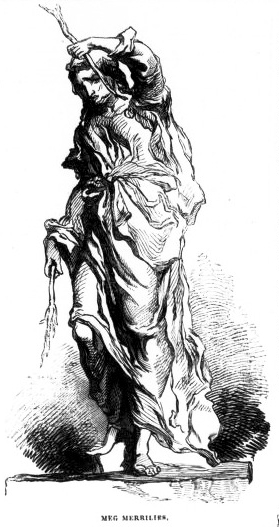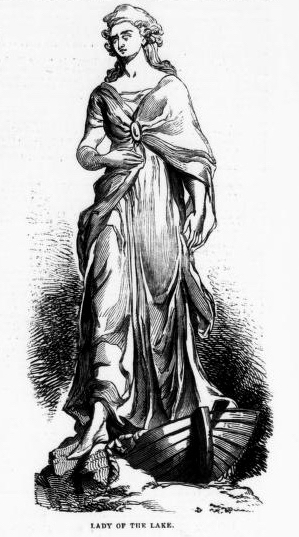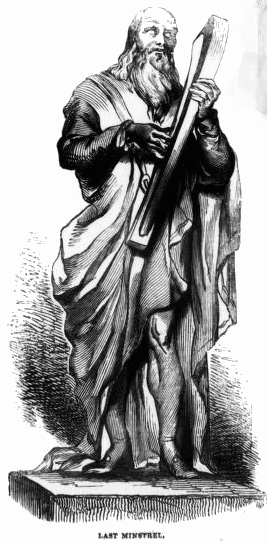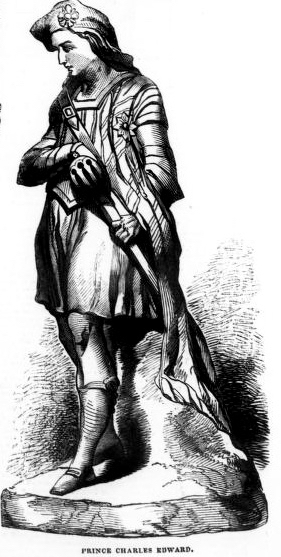
Four Principal Figures from the Archways of the Scott Monument (1845)
Sculptor Alexander Handyside Ritchie (1804-70) has depicted
Meg Merrillees, the central figure
over the arch on the east face of the monument, from Guy Mannering;
or, The Astrologer (1815), as a young Gypsy holding a green bough (fashioned from
copper). The sculptor "Represents her as a sibyl in frenzy, at the time when standing on
a bank which overhung the road, — with a roll of cloth on her head in the form of a
turban, her long and tangled hair falling in elf locks on her neck and shoulders, and a
piece of broken sapling in each hand, — she delivered the fearfully prophetic
address to Godfrey Betram regarding the ruin of his house" (Colston, 97).
Sculptor Peter Slater, R. A. (1809-60), has depicted Ellen Douglas, the central figure on the archway of the
south face, from The Lady of the Lake (1810). The Lady from
Scott's narrative poem is "Represented in the act of stepping out of a boat to the shore.
She is attired in garments of flowing drapery" (Colston, 96).
Sculptor James Ritchie (1809-88) has depicted The Harp o' the North or the principal figure in The Lay of the Last Minstrel (1805) as if he were Sir Walter Scott
himself. He appears above the archway on the west face of the monument.
Sculptor Alexander Handyside Ritchie (1804-70) has depicted Prince Charles Edward Stewart or Bonnie Prince Charlie, from both Waverley (1814) and Red Gauntlet (1824), as
the central figure over the archway on the north face of the Walter Scott Monument. The
Stuart claimant to the British throne is "Represented in the act of drawing a claymore,
dressed in highland costume, with bonnet and cockade" (Colston, 97) as he must have
appeared at the ill-fated Battle of Culloden (1745).
Detail of the Gothic Spire from The Walter Scott Monument
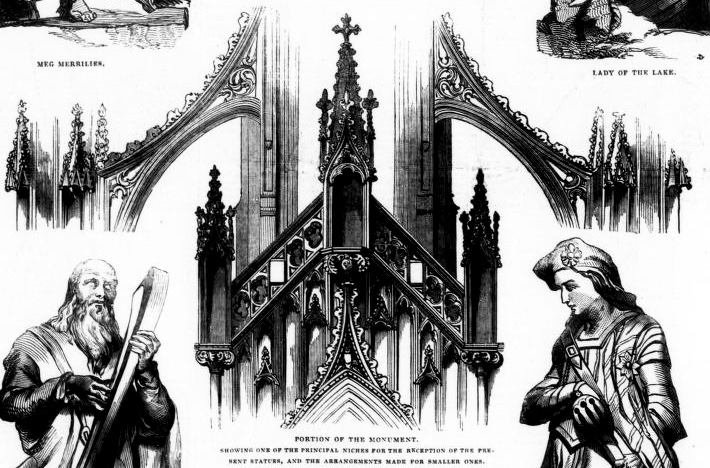
Related Material: Photographs of the Scott Monument
Detail of tower (1)
Detail of tower (2)
John Steell's statue of Scott (front view)
John Steell's statue of Scott (side view)
Sir Walter Scott (1771-1832):
Homepage
Sir Walter Scott
Monument, Edinburgh
Statue, Sir Walter Scott
Monument
Scanned image and text by Philip V.
Allingham. [You may use this image without prior permission for any scholarly or
educational purpose as long as you (1) credit the person who scanned the image, and (2)
link your document to this URL in a web document or cite the Victorian Web in a print one.]
Bibliography
Colston, John. History of the Scott Monument,
Edinburgh. Edinburgh, 1881. Rpt. Pitfield, Milton Keynes: Legare Street Press.

"Inauguration of the Scott Monument, Edinburgh." The
Illustrated London News, No. 225, Vol. 9 (22 August 1846): 113-114.
"Scott Monument." Wikipedia. Viewed 20
September 2007.
Watt, Francis M., and Andrew Carter. "Title-page Vignette: The Scott
Monument." Picturesque Scotland: Its Romantic Scenes & Historical
Associations Described in Lay and Legend, Song and Story. London: John M. Murdoch
[1887?].
"Waverely Ball, Edinburgh — Statues for the Scott Monument." The Illustrated London News, No. 154, Vol. 6 (12 April 1845): 237-238.
Victorian
Web
Visual
Arts
Illus-
tration
Scotland
Next
Created 17 June 2025
